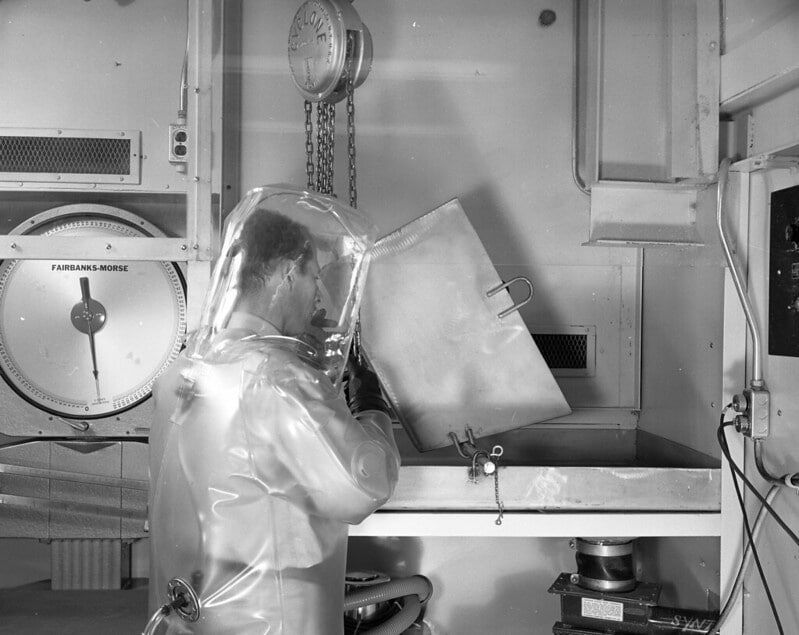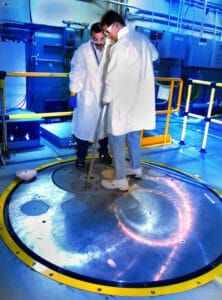Molten salt reactors were trouble in the 1960s—and they remain trouble today
By M.V. Ramana | June 20, 2022
 A technician prepares salts for use in MSRE in 1964. By Oak Ridge National Laboratory. Accessed via Flickr. CC BY 2.0.
A technician prepares salts for use in MSRE in 1964. By Oak Ridge National Laboratory. Accessed via Flickr. CC BY 2.0.
Molten salt nuclear reactors are all the rage among some nuclear power enthusiasts. They promise designs that will soon lower emissions from shipping, be cheaper to run and consume nuclear waste, and be transportable in shipping containers. The Canadian government has provided two companies, Terrestrial Energy and Moltex, with tens of millions of dollars in funding. Indonesia’s Ministry of Defense has sponsored a study of thorium-based molten salt reactors. The International Atomic Energy Agency organized a webinar calling molten salt reactors “A game changer in the nuclear industry.” Unsurprisingly, China has plans to build one.

Unlike other nuclear reactor designs that can claim multiple roots, the technology underlying molten salt reactors has a fairly clear origin: the Oak Ridge National Laboratory in Tennessee. All molten salt reactors are based, in one way or another, on the Molten Salt Reactor Experiment that operated at Oak Ridge from 1965 to 1969. That experimental reactor, in turn, was based on another experimental reactor, the Aircraft Reactor Experiment, that had operated a decade earlier at the same facility.
Among developers, the Molten Salt Reactor Experiment has a legendary status. For example, in 2015, an official from Terrapower, the nuclear venture funded in part by Bill Gates, noted that his company was “excited to celebrate and build upon” the experiment by designing a molten chloride fast reactor. His accompanying slide show reinforced the message with pictures of the Molten Salt Reactor Experiment assembly, the red hot heat exchanger, and Alvin Weinberg, the leader of Oak Ridge at that time, noting that the experiment had operated for 6,000 hours. Also in 2015, Terrestrial Energy’s David LeBlanc made “a kind of pilgrimage to Oak Ridge” to celebrate the 50th anniversary of the Molten Salt Reactor Experiment becoming critical.
Many molten salt reactor developers and proponents seem to have decided that the Molten Salt Reactor Experiment experience was so successful that all that remains is for it to be scaled up and deployed across the world. But is this really the case? A careful look suggests otherwise.
Molten salt reactors’ early history. Molten salt reactors go back to the US Air Force’s failed effort to build a nuclear-powered, long-range bomber aircraft. The Air Force spent more than $1 billion (over $7 billion in today’s dollars) between 1946 and 1961 on its Aircraft Nuclear Propulsion program. President John F. Kennedy, seeing how little had been achieved, told Congress on March 28, 1961 that the possibility of success in the foreseeable future was “still very remote” and recommended terminating the program.
As part of this effort, the Air Force made Oak Ridge National Laboratory responsible for building the Aircraft Reactor Experiment as part of its effort to fly a bomber on nuclear power. The 2.5 megawatt reactor operated for a mere nine days in November 1954. Some Oak Ridge officials considered running the reactor longer, but others grew concerned about overheating of one of the reactor components. That concern was legitimate; five days later, this component failed and “released radioactive gas into the reactor compartment.” But Oak Ridge National Lab officials were undeterred. For them, the experience showed “the feasibility of molten-salt fuel” and they “persuaded the Atomic Energy Commission to fund a study of molten-salt power reactors.” In 1958, the commission did just that, and thus began the Molten Salt Reactor Experiment.
To understand the interest in molten salt reactors, start by adopting a 1950s mindset. At the time, nuclear power was expected to expand rapidly, and some energy planners were worried that there would be insufficient uranium to fuel all the reactors to be built over upcoming decades. Alvin Weinberg, the head of Oak Ridge, expressed this eloquently when he prophesized that humanity would need to “burn the rocks” in what are called breeder reactors in order to live a “passably abundant life.” While the dominant types of reactors around the world (light water reactors and heavy water reactors) use only a small fraction of the uranium and thorium found in the Earth’s crust, breeder reactors can exploit a much larger fraction of these minerals.
The concern among nuclear power advocates about running out of uranium was also at the heart of another major nuclear development during this period: the liquid metal (sodium) cooled fast breeder reactor. These reactors were an effort to tap the energy present in the uranium-238 isotope that is not used in standard light and heavy water reactors by converting it into plutonium. Glenn Seaborg, who discovered the element and rose to become Chairman of the US Atomic Energy Commission from 1961 to 1971, predicted in 1970 that, by the year 2000, plutonium “can be expected to be a predominant energy source in our lives.” By contrast, the molten salt reactors were mostly intended as a pathway to use thorium, which was more plentiful than uranium, by converting it into uranium-233.
In retrospect, these expectations proved mistaken in three ways. First, energy demand has risen much more slowly, both in the United States and globally, than predicted. For example, in 1959, Weinberg assumed that the global population would stabilize at 7 billion and that it would need at least 1.9 billion, billion BTU per year. In comparison, in 2020, the world used a little over a quarter of this level of energy for nearly 8 billion people.
Second, nuclear energy proved much more expensive than envisioned in the heady “too cheap to meter” era. As nuclear power’s poor economics became apparent, reactor construction declined dramatically and has never achieved anywhere near the levels seen in the 1970s and 1980s. (Accidents at Three Mile Island and Chernobyl only reinforced this trend.) The United States illustrates the drastic difference between expectation and reality. The Atomic Energy Commission projected that US nuclear power generating capacity in 2000 would be 1.1 million megawatts (or 1,100 gigawatts). In fact, US nuclear capacity only reached a maximum of 101 gigawatts, and it has since declined to less than 95 gigawatts as of June 2022 (after the Palisades reactor was shut down). Globally, nuclear energy’s share of electricity generation has sunk from a maximum of 17.5 percent in 1996 to just over 10 percent in 2020.
Third, uranium proved to be more ubiquitous than anticipated, and global uranium resource estimates have continuously increased. The International Atomic Energy Agency and the Organization for Economic Co-operation and Development’s Nuclear Energy Agency calculate that the world’s resources of cheaply available uranium ore are adequate to fuel the global reactor fleet, even in the event of an increase in nuclear power generation.
All of these realizations were, of course, only to be had in the future. In the 1950s, when the molten salt reactor programs were actively pursued, there was an air of urgency. This urgency was reflected in the break-neck speed with which the Molten Salt Reactor Experiment, Oak Ridge’s proposal for the next step in the molten salt reactor research process, was designed and constructed. As one of the Oak Ridge team leaders described it, “Design of the [Molten Salt Reactor Experiment] started in the summer of 1960, and construction started 18 months later, at the beginning of 1962. The reactor went critical in June 1965.”
In 1965, when the reactor started operating, it was fueled by a mixture of 150 kilograms of depleted uranium and 90 kilograms of weapons-grade, highly-enriched uranium (93 percent of uranium-235). After March 1968, the fuel was changed to one involving another weapons-usable material, uranium-233, which was derived from thorium. After this switch, the Molten Salt Reactor Experiment went critical in October 1968 and reached full power in January 1969. But at the end of that year, the experiment shut down. No more molten salt reactors have been built since.
The Molten Salt Reactor Experiment operation. Proponents of molten salt reactors have claimed for decades that the Molten Salt Reactor Experiment operated successfully. Indeed, they started making this claim even when it had barely started operating. In May 1966, for example, Paul Haubenreich, Oak Ridge National Laboratory associate director, cockily announced that the experiment “will live up to the name which we think goes with the initials M.S.R.E.—Mighty Smooth Running Experiment.” This, after listing many problems, including a basic one that was never resolved.

That basic problem was the reactor’s power level. The Molten Salt Reactor Experiment was designed to produce 10 megawatts (MW) of heat. The power level is given only in terms of heat production because its designers did not even try to generate electricity from the power produced in the reactor. Instead, the experiment just dissipated the heat produced to the surrounding air.
But this design power level was never reached. As Haubenreich described while pronouncing that the experiment was running “mighty smooth,” the operators “ran into some difficulties” and could only operate “at powers up to 5 MW.” Nevertheless, he expressed the confident expectation that the reactor would “be at 10 MW within a couple of weeks.” In fact, Haubenreich later admitted in a paper written after the reactor was shut down, the highest power level it reached was only 8 MW. (One Oak Ridge publication even says 7.4 MW.) It turned out that the designers of the reactor had “miscalculated the heat transfer characteristics” of the system used for dissipating the heat produced into the atmosphere, and the reactor could not operate at its intended power level.
Even for this lower power output, operations were anything but smooth. At the most general level, the fact that the reactor operated for just 13,172 hours over those four years, or only around 40 percent of the time. In comparison, the average commercial nuclear power plant in the United States operates at upwards of 90 percent of the time. The longest periods of sustained high power operations in the Molten Salt Reactor Experiment were between February to May in 1967 and late January to May in 1969.
During its operational lifetime, the Molten Salt Reactor Experiment was shut down 225 times. Of these 225 interruptions, only 58 were planned. The remaining interruptions were due to various technical problems, including: “chronic plugging” of the pipes that led into charcoal beds intended to capture and remove radioactive materials so the reactor could operate; failures of the blowers that removed the heat produced in the reactor; and fuel draining through the so-called freeze valve safety system intended to prevent an accident.
These frequent failures led to a large gap between the proposed operating schedule and the actual operations of the Molten Salt Reactor Experiment. For example, the proposed schedule called for the experiment to run at full power (i.e. 8 MW) from May to early August in 1968. But the reactor was down from April to July of that year.
One persistent problem was with the electrical system, which experienced “eleven important failures.” Of these, five were “caused by electrical storms, one by a cable failure at a component-cooling pump, one by an overload of the main process-power breaker, one by an arc between a 13.8-kV line and an activator rod to the line fuse, one by a failure of the main transformer primary fuse, one by a failure of the auxiliary transformer primary fuse, and one by a failure of the drain-tank space cooler motor. These interruptions varied in length from a few minutes to several days.” Such unexpected failures and shutdowns ended only in December 1969, when the Molten Salt Reactor Experiment was shut down.
The patchy experience of the experiment was by no means unique. Many other reactor designs have been plagued by unreliable operations and frequent shutdowns, that in many cases only became worse when scaled up. Consider, for example, sodium cooled fast breeder reactors. France, the country most reliant on nuclear power, tried to commercialize this technology after operating pilot-scale and demonstration reactors. This “commercial” version was the Superphénix, which started operating in 1986, experienced a series of accidents, and was shut down in 1997. During this period, it generated less than 8 percent of the electrical energy of what it would have generated running at full power round-the-clock. In the United States, the first and only commercial sodium cooled breeder reactor, Fermi-1, suffered a disastrous meltdown in 1966 as a result of a series of failures that had been dismissed as not credible by reactor engineers. Likewise, high-temperature, gas-cooled reactors have historically performed poorly.
The Molten Salt Reactor Experiment aftermath. For Oak Ridge officials and other molten salt reactor proponents, these problems with the Molten Salt Reactor Experiment were not worthy of significant concern. They moved forward with plans to build a larger molten salt breeder reactor. (Remember that the ultimate goal was to use thorium to breed nuclear fuel.) But the experiment did identify major hurdles in the path of building reliable molten salt reactors.
Here’s a key concern: Materials used to manufacture molten-salt-reactor components must maintain their integrity in highly radioactive and corrosive environments at elevated temperatures. The corrosion is a result of the reactor’s nature, which involves the use of a fuel consisting of uranium mixed with the hot salts for which the reactor is named. As anyone living near a seashore knows, chemically corrosive salt water eats most metallic objects.
To deal with this problem, Oak Ridge developed a new alloy known as IN0R-8 or Hastelloy-N in the late 1950s. While Hastelloy-N did not get significantly corroded—at least during the four years of intermittent operations—it had two significant problems. First, the material had trouble managing stresses. It became brittle, for example. Second the material developed cracks on surfaces exposed to the fuel salt. Both of these could lead to the component failing.
These problems remain relevant. Even today, no material can perform satisfactorily in the high-radiation, high-temperature, and corrosive environment inside a molten salt reactor. In 2018, scientists at the Idaho National Laboratory conducted an extensive review of different materials and, in the end, could only recommend that “a systematic development program be initiated.” In other words, fifty years after the molten salt reactor was shut down, technical experts still have questions about materials development for a new molten salt reactor design.
A few years after the Molten Salt Reactor Experiment was shut down, the Atomic Energy Commission terminated the entire molten salt reactor program, although it continued to fund the molten salt breeder reactor program until the end of fiscal year 1976.
Molten salt reactor proponents view the termination of funding as a result of either institutional politics or historical factors. They point to Milton Shaw—the head of the Atomic Energy Commission’s Division of Reactor Development and Technology—and his strong preference for the liquid metal fast breeder reactor. As Oak Ridge National Laboratory program director Herbert MacPherson put it, the “fast breeder program… got an early start and had copious government development funds being spent in many parts of the United States. When the [molten salt reactor] development program had progressed far enough to justify a greatly expanded program leading to commercial development, the [Atomic Energy Comission] could not justify the diversion of substantial funds” from these efforts. MacPherson suggested that the institutional problem was that the “political and technical support” for molten salt reactors was “too thin geographically.”
Director Alvin Weinberg’s explanation revolved around the historical domination of nuclear power by physicists. In a letter to Glenn Seaborg, he wrote, “our problem is not that our idea is a poor one—rather it is different from the main line, and has too chemical a flavor to be fully appreciated by non-chemists.”
But these explanations disregard the technological problems of molten salt reactors. Indeed, anyone who looked at the spotty operating record of the Oak Ridge reactor ought to have been skeptical about this technology. The subsequent failure of the seemingly more promising fast breeder reactor technology should prompt greater skepticism, not less.
The Atomic Energy Commission, for its part, justified its decision in a devastating report that listed a number of problems with the large molten salt reactor that Oak Ridge scientists had conceptualized. The list included problems with materials, some of which have been earlier described; the challenge of controlling the radioactive tritium gas that is produced in molten salt reactors; the many large components, such as steam generators, that woud have to be developed from scratch (as researchers had no experience with such components for a molten salt reactor); the difficulties associated with molten-salt-reactor maintenance because radioactive fission products would be dispersed throughout the reactor; some safety disadvantages (though these are balanced by pointing out some of the safety advantages); and problems with graphite, which is used in molten-salt-reactor designs to slow down neutrons, because it swells when subjected to the nuclear reactor’s high radiation doses.
Other institutions too questioned the idea. A 1975 Office of Technology Assessment report listed the pros and cons of maintaining support for the molten salt breeder reactor program. An important set of arguments listed there proved prescient: “the [molten salt breeder reactor] may never work, its economics would be doubtful even if it did, and the chances of needing it are small.” As a result, in the years after the Molten Salt Reactor Experiment was shut down, many arguments were advanced to abandon the molten salt route, including not throwing good money after bad.
The Molten Salt Reactor Experiment’s long difficult tail. When one looks for publications with the title “molten salt reactor experiment” on the University of British Columbia library page, only nine results, all published before 1975, pertain to the actual operations of the reactor. The remaining 41, including a 1984 report titled “Preliminary decommissioning study reports: Volume 5, Molten Salt Reactor Experiment,” all deal with managing the reactor components or the radioactive materials involved in the experiment. The distribution of the numbers of papers indicates the challenge of dealing with the waste resulting from a small molten salt reactor.
Dealing with radioactive salt wastes involves at least two separate concerns. The first, ongoing problem is that managing the radioactive salts that contain the uranium isotopes and the fission products is difficult. In the 1990s, researchers discovered that uranium had migrated and settled in other parts of the facility, leading to the possibility of an accidental criticality.
The second challenge is that of securely storing the uranium-233 from the Molten Salt Reactor Experiment. Although the uranium-233 used in the Molten Salt Reactor Experiment is but a small part of the larger US stockpile of the substance, it occurs in chemical forms that are difficult to manage. Further, urarnium-233 is usable in nuclear weapons, and any loss of this material might lead to security concerns.
In all, the costs incurred so far have run into the hundreds of millions of dollars—dozens of times the cost of constructing the reactor itself. Oak Ridge continues to spend around ten million dollars (roughly the cost of the reactor) every year, just to manage these wastes on site. In addition to the problems mentioned above, there are miscellaneous challenges requiring expensive engineering. For example, Oak Ridge began a $4.7 million project in 2019 to upgrade electrical and fire suppression systems.
Assuming that these challenges can all be managed, Oak Ridge and the Department of Energy will also need to address the ultimate challenge of trying to dispose of these wastes in some kind of a geological repository. Uranium in molten salt reactors is in chemical forms that are “not known to occur in nature” and waste disposal experts are unclear “which, if any, disposal environment could accommodate this high-level waste.”
Molten salt reactors are a bad idea. The Molten Salt Reactor Experiment’s history is riddled with extensive problems, both during its operational lifetime and the half century thereafter. These problems were not accidental but a result of the many material challenges faced by the reactor itself.
Any other molten salt reactor will encounter these problems too. France’s Institut de Radioprotection et de Sûreté Nucléaire, the Nuclear Innovation and Research Office in the United Kingdom, and other research laboratories have all drawn this conclusion. According to the Institut de Radioprotection et de Sûreté Nucléaire, “numerous technological challenges remain to be overcome before the construction of an MSR can be considered.”
Should molten salt reactors ever be constructed, they are unlikely to operate reliably. And if they are deployed, they would likely result in various safety and security risks. And they would produce several different waste streams, all of which would require extensive processing and would face disposal related challenges. Investing in molten salt reactors is not worth the cost or the effort.
This article has benefited from research support from Maggie Chong, a materials engineering student at the University of British Columbia.
Together, we make the world safer.
The Bulletin elevates expert voices above the noise. But as an independent nonprofit organization, our operations depend on the support of readers like you. Help us continue to deliver quality journalism that holds leaders accountable. Your support of our work at any level is important. In return, we promise our coverage will be understandable, influential, vigilant, solution-oriented, and fair-minded. Together we can make a difference.
















While I appreciate pushing back on how excited some people are about next generation nuclear tech, research costs money and finds problems to solve with more research. We are talking about tech from the 1960s. This was developed and engineered by hand. Until fusion is widespread and/or we are using net zero fossil fuels via low environmental impact renewables, it should not be limiting our research options. Molten salts are being used for energy storage now in some renewable projects. Better materials developed for MSRs would make it possible to run reactors at higher temperature and safer for longer. Getting… Read more »
I agree wholeheartedly. We must do the materials research to see it the liquid salt Thorium reactor is practical for power generation. My other comment is that any form of fusion that produces neutrons in neither clean nor green. A practical fusion reactor for power generation must use an aneutronic reaction preferably the proton Boron 11 reaction. The main use of D-T fusion (inertial confinement) would be to simulate the radiation from nuclear weapons. D-T Tokamak fusion is great plasma physics but not a practical power reactor.
This article is written by an activist. Not a Physicist. This person doesn’t know what they are talking about. My wife has run actual reactors and every actual physicist, not journalist, not a BA, likes molten salt and other reactors. Stop fighting nuclear, it’s hundreds of times less polluting than solar or wind. There are very few numbers and a when lot of emotion here.
Your general response to this article does nothing to change my already skeptical opinion of molten salt reactors. Besides the many concerns with the toxic waste streams created by molten salt reactors there are the issues with the power output goal never being achieved nor was reactor able to run without frequent shut downs as stated in the article none of which you addressed. Your cheerleader approach to going nuclear consistently ignores the numerous short comings of these molten salt reactors. Others trumpeting the positives of these reactors do the same thing! In addition to the concerns with molten salt… Read more »
Rational skepticism should be our default position where science, research, and new technology are concerned. But rational skepticism is why we do experiments and tests in the first place. It’s not rational if it is used as a roadblock against attempting anything new.
Several molten salt fast reactors are being developed specifically to consume our current stockpiles of spent fuel. Spent fuel is typically around 4% fissioned. 96% of its potential energy is still there. Depleted uranium still has 100%. We just need the right kind of reactor to extract it.
The non-breeding “burner” type reactors will not only be able to burn the remaining U-235 in the spent nuclear fuel coming out of PWR, but all fissile fuels like present when the spent fuel was added or subsequently bred from the U-238. Pu-239 the major long lived “waste” that gets everybody’s panties in a bunch. But is only a waste because we won’t even consider anything but a one-pass nuclear fuel cycle.
From wiki
M. V. Ramana obtained his Ph.D. in Physics from Boston University in 1994 and was a post-doctoral fellow at the Department of Physics, University of Toronto and the Center for International Studies, Massachusetts Institute of Technology. In 2014, Ramana received the Leo Szilard Award of the American Physical Society.
“M. V. Ramana obtained his Ph.D. in Physics from Boston University” Having a degree in a field does not automatically make one a practitioner in that field. On that same Wiki page is a list of articles, 100% of which are advocacy and social policy articles. Google scholar lists him as a contributor to two physics papers, both from the time of his doctoral and post-doc studies, and neither being related to the physics of nuclear power. Since that time, he’s written over 190 articles, papers and books concerning nuclear policy, with roughly zero on that list having to do with physics. And the… Read more »
“This article is written by an activist. Not a Physicist. “
It appears that your first sentence is completely false. The rest of your argument follows.
Planet wide there are dozens of companies and research entities sponsored by governments looking into developing Molten Salt reactor technology. They are all benefiting by 60 years of advances in materials technologies, instrumentation technology and computing technology. There are also regional industrial bases that I’ve been working with Nuclear Power for decades. I have been reading the bulletin for years. A big concern is meltdown of solid Fuels in a Reactor. MSR’s Technology is a high temperature platform that uses a liquid fuel that doesn’t begin to operate until the fuel salts are melted at several hundred degrees C. They… Read more »
Despite one’s personal beliefs about molten salt reactors, this is clearly a hack job of an article. The only thing this article is doing is smearing MSRs. The one clever thing about this article is that the author hid the true agenda. There’s no mention of what should be done or wear any funding be properly distributed? I’ll be the first to admit that I am nowhere involved in the nuclear community. I was lucky enough that some of my travels took me to oak ridge national Labs where I first heard about MSRs. However, Even being out of academics… Read more »
I’m surprised there is no reference of Hanford, WA’s Fast Flux Test Facility (FFTF) in the article. The FFTF was a molten sodium cooled atomic reactor which succesfully conducted tests related to this technology for several years.
It is almost impossible to discern which are legitimate concerns vs a bunch of fear mongering when the author continually and repeatedly uses a breeder reactor and power generating reactor an synonyms. This whole article wreaks of disengenousness and deception. It’s as if someone were advocating against ICE and proceeded to treat semi trucks and Ferrari’s as if they were the same thing and used for the same purpose. This is made even worse by the fact that no one anywhere is advocating for molten salt breeder reactors. So my question would be, can redo this article without the irrelevancy’s… Read more »
The molten salt fast reactor teams (Moltex, Elysium, Terrapower-Southern) are trying to develop power reactors which could operate as breeders.
Essentially burning the ‘fuel’ as they convert thorium to uranium. Not the same thing as the breeder reactor which produced fuel that had to be separated out from the spent fuel.
Basically correct, except they’ll be converting uranium to plutonium for the fuel. Not having to separate out the fuel would be the main advantage over molten salt thorium reactors.
I certainly don’t agree: #1 Several design schemes today use heterogeneous fuel with molten salt coolant – way better. #2 The “basic problem” mentioned of power level is not intrinsic. Calculations back in the 60s were very crude. #3 Reactor accidents, some rather infamous, occurred with PWR technology experimental designs. Paying farmers to peel fuel from containment walls – insanity. #4 Materials are much better today and cost much less. #5 If the Reactors coolant system leaks in a molten salt cooled reactor the coolant itself seals the leak, and the low pressure single phase means Containment buildings are far… Read more »
For any who were unsure of the meaning of point #1, this refers to reactors where the fuel is separate from the molten salt, and the salt is used for heat transport and some neutron moderation only. This point has gained in significance since this comment was posted. With the NRC’s issuance of a build permit for the Kairos Power Hermes Unit 1 reactor–the first build permit for a non-water-cooled reactor design in NRC history–Kairos now has the de-facto lead MSR design in the U.S. (with a further permit application for a 2-reactor Unit 2 already submitted). This reactor would basically be like… Read more »
Considering the MSRE was an experiment from the slide-rule era, operating for 40% of the time over 4 years sounds pretty successful. (Better than solar PV.) But the performance of an experiment doesn’t mean commercial designs will do no better. The first powered flight lasted 11 seconds. It did not take long to improve on that greatly. Did the MSRE reveal problems? Yes. That’s what experiments are for. Have we solved all of those problems since then? No–which is hardly surprising considering molten salt research and development was effectively halted in the 70’s and didn’t start up again until just recently. Also, we are only now starting work on molten… Read more »
Very well written response!
Brings to my mind the quote, “If we knew what we were doing, we wouldn’t call it research.”
https://asociologist.com/2010/09/04/adventures-in-fact-checking-einstein-quote-edition/
It sounds like the author is unhappy because the brand new technology didn’t work perfectly out of the gate.
Why question: why can’t we continue to make it better?
What would the reaction be to solar panels if they were stuck with science from the 1960s?
Weirdly the author is not able to explain why thorium molten-salts reactors were discarded in the first place: They could not be used to create atom bombs. This is why we are stuck with a technology is inherently dangerous.
Thorium-based nuclear power – Wikipedia
The kinds of reactors we wound up with produced zero atomic bombs. (They did, however, destroy the bomb fuel from 20,000 atomic bombs.) Thorium reactors would breed U-233, which would be an excellent bomb fuel. It has a bare-sphere critical mass of only 15 kg. (With neutron reflectors, you’d only need about 7 kg. to make an operational bomb.) For pure U-235 (which is unattainable) the bare-sphere critical mass is 52 kg. The Soviet Union used U-233 to boost the performance of their first thermonuclear bomb (RDS-37). For the live test, the yield turned out to be 150 kilotons (roughly ten Hiroshima bombs)… Read more »
U-233, by itself, would indeed make a great fission bomb. Being almost the only Uranium in the thorium the UF6 gas that comes bubbling out of the molten salt would be almost 100% fissile. But it doesn’t appear by itself when bred from Th-232. Some small amount of U-232 is also produced and would be even harder to separate from U-233 with just one neutrons difference in mass than U-235 is from U-238. And U-232 looks to be a problem for anybody who would want to divert U-233 out of the fuel chain to make a fission weapon. The decay… Read more »
It is clear that the article is a conclusion in searchnof an argument. I would truly like to see the likes of Micheal Schellenberger of Environmental Progress or David Leblanc the Chief Operating Officer at Terrestrial Energy, either of whom could provide an authoritative rebuttal to much of the BS in the article. Not that anything said is a lie; no, worse these are semi truths presented in a way that lead one to conclude the contrary to what the facts actually say. I won’t even try to rebute anything in the article, but instead I will just say that… Read more »
I agree fully.
I was wondering if the issue of Tritium may be managed through storing it for 87 years or so (based on a rough back of the envelope calculation, using the 12.3 years’ Tritium half-life) Tritium naturally decays via Beta radioactive emission, to Helium-3 with less than 1% Tritium remaining.
The Helium-3 may be used to power future thermonuclear fusion reactors and to help fill the increasing global demand for Helium?
https://physicstoday.scitation.org/do/10.1063/pt.6.2.20200605a/full/
https://science.osti.gov/np/Research/IDPRA/3He-Fact-Sheet
#1 Your diatribe over the Air Force’s expenditures on the nuclear-powered bomber program and the MSR is disingenuously conflated. #2 Today is not 1960, and since then there have been quantum leaps in material science that dispense with all problems alluded to. #3 All the fuel required to run MSR disposes of existing nuclear waste/spent fuel. #4 There is less than 20% of waste nuclear fuel from an MSR than from LWRs and have half-lives less than 1/3 that of LWRs, #5 Most of the nuclear fuel waste from MSRs is valuable for reprocessing for medical applications.
In todays LWRs 96.4% of the spent fuel rods really is unspent fuel.
I’m sorry but articles that look at 60’s technology and say ‘if man were meant to fly..” don’t excite me. Some parts are just irrrelevant (low enriched uranium from depleted plus highly enrich, for example) The current designs learned from the mistakes of the ‘prototype’ and condemning the newest SMR’s for the problems back then is just propaganda. Like condemning modern airplanes by pointing to the deficienecies of the Wright Flyer. The biggest problem with the 60’s was the construction of ‘one off’ designs based on light water (which was never safe outside of the nuclear submarines it was designed… Read more »
The Oak Ridge reactors were prototype/research reactors. They were not meant to be perfect. They were there for science and engineering. MSR technology can not advance without new MSR reactors using the best science, materials engineering, electronics and technology that are available now. In fact the Oak Ridge reactors worked successfully for what they were built for. We now have 1 MSR reactor prototype in China. The US and Russia should have reactors working by 2030. The large amounts of research developed by Oak Ridge is now freely available for anyone to use. The premise for the first MSR reactor… Read more »
What a load of rubbish, trying to pass itself off as researched fact. Clearly an anti-nuclear campaigner with an illogical and prejudiced opinion to inflate. Imagine if mankind never tried to make anything work. Does the author really think that we made it this far by giving up on anything that didn’t work first time? The demise of the MSR was politically and militarily motivated. Mr Weinberg was never going to beat the heavy hitters that were against him, but he correctly pointed out that PWRs are inherently dangerous and must be engineered safe, which is very expensive and can… Read more »
I think there’s nothing wrong with this article, if it had been submitted for publication way back in 1969. With apologies to Dr. Ramana, today over half a century later, this article looks like an ill researched public opinion piece reading like political anti-nuclear propaganda. The quality of the material and discussion presented, feels like something that would be written by a first year undergraduate political science STEM challenged student and not a modern Physicist or Nuclear Engineer. Perhaps my expectations were set too high and I was expecting to read a much better formulated and informed opinion piece, taking… Read more »
Tell us what you really think — not what the folks you work for depend on for funding.
China (of course) is planning to start up their first MSR in production this September — https://spectrum.ieee.org/china-closing-in-on-thorium-nuclear-reactor, and they’re STILL LAUGHING AT US.
Hi bulletin folks, I just left a comment a few minutes ago. I’m doing this on my smart phone and I swear it re-edit stuff after I hit send. If you choose to print my comment could you use this re-comment and cancel the one from earlier today. Keep up the good work, you keep me informed and I use your articles on my radio show sometimes. Revised comment: Apologies for the texting errors of my prior comment on this article by M.V. Ramana. The criticism leveled at Molten Salt Reactor technology is unjustified. The US government conducted two MSR… Read more »
This seem more like a hack job than any evaluation of how successful molten salt reactor experiment was. Examples include “It never achieved full power”. Well of course not, full power would have exceeded the capacity of the heat radiators. The total amount of power output was never one of the goals of the project. “The reactor kept being shut down” implying that this was because of reactor problems. Come on now. The big plus for this reactor was it’s ability to easily shut down and restart. Most reactors including Chernobyl have problems with quick restarts, not this reactor. Like… Read more »
One example from his writing: “At the most general level, the fact that the reactor operated for just 13,172 hours over those four years, or only around 40 percent of the time. In comparison, the average commercial nuclear power plant in the United States operates at upwards of 90 percent of the time. The longest periods of sustained high power operations in the Molten Salt Reactor Experiment were between February to May in 1967 and late January to May in 1969.” Now how can you in your right mind even begin to compare more than 400 PWR reactors that have been running professionally and operationally… Read more »
The very first steam engine by Thomas Newcomen was plagued by technical difficulties, due to the revolutionary nature of the technology, and the relatively primitive state of the art in materials at the time. Perhaps we should have given up at the first attempt and just continue using horses?
The future is nuclear. And quite possibly thorium salt based.